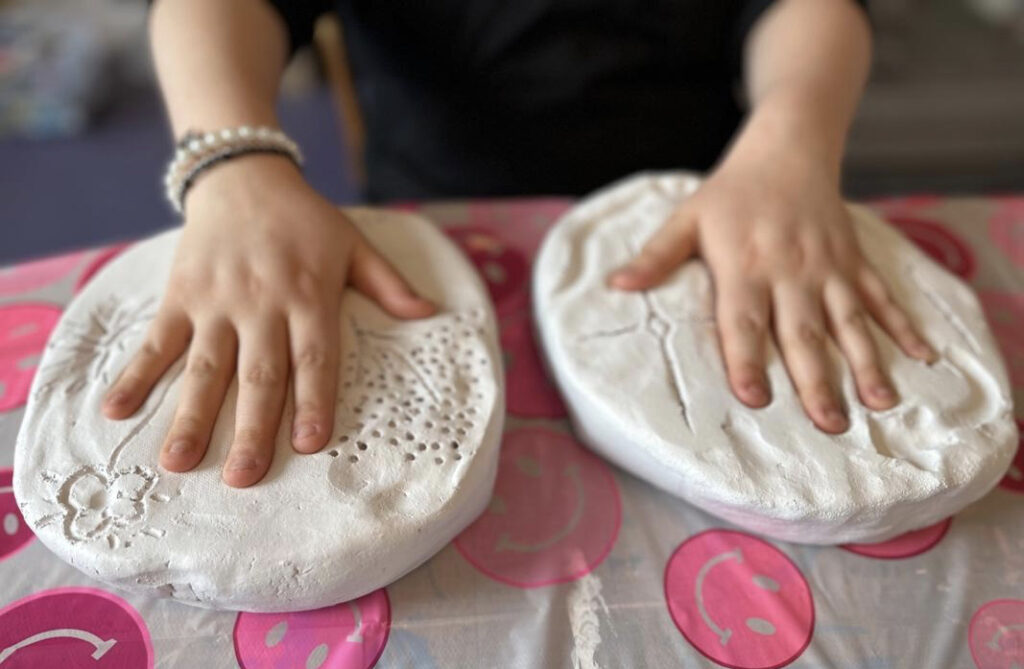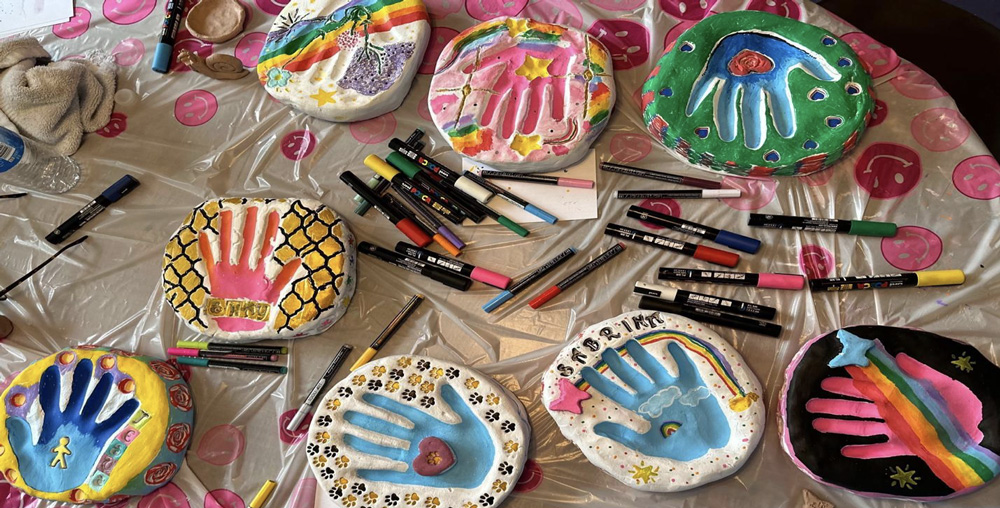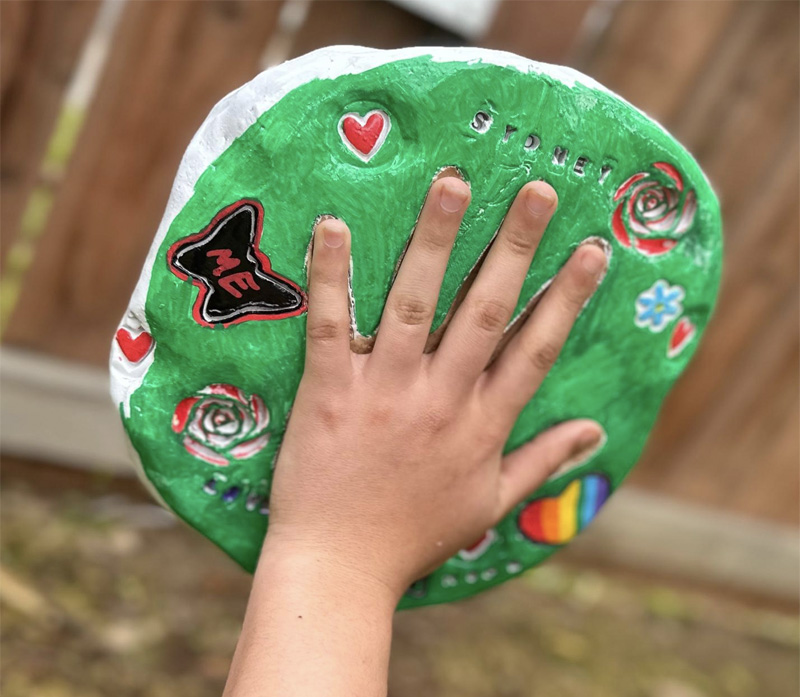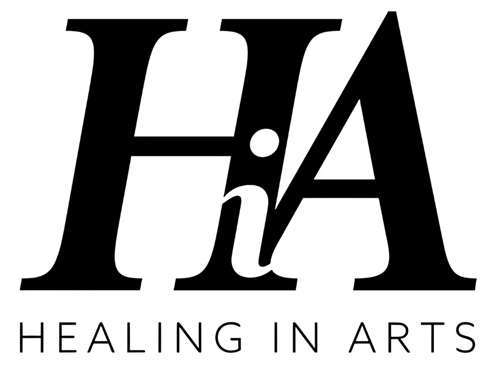 In February I worked with Healing in Arts, an art-focused 501(c)(3) nonprofit, in collaboration with Mollie’s House, a safe house in central California housing teenage girls rescued from sex trafficking. I had a vision of an outdoor garden exhibit inspired by these sacred words: “See, I have engraved you on the palms of My hands” (Isaiah 49:16, NIV). The Mollie’s House participants pressed their handprints into clay as a reminder to each of them that their names are engraved on God’s hands—a visual witness of their value to God.
In February I worked with Healing in Arts, an art-focused 501(c)(3) nonprofit, in collaboration with Mollie’s House, a safe house in central California housing teenage girls rescued from sex trafficking. I had a vision of an outdoor garden exhibit inspired by these sacred words: “See, I have engraved you on the palms of My hands” (Isaiah 49:16, NIV). The Mollie’s House participants pressed their handprints into clay as a reminder to each of them that their names are engraved on God’s hands—a visual witness of their value to God.
A month before we gathered, I contacted the art department at nearby Fresno Pacific University, asking for their help with the project. Immediately, a group of professors responded with an enthusiastic “Yes.” Over the next couple of weeks, we emailed, phoned, and met virtually to construct a plan. Each step of the project—purchasing the materials, drying and firing clay, weatherproofing the work, and gluing the clay images to metal stakes—needed to be carefully choreographed to meet our two-week deadline. The date of unveiling had already been publicized.
Two professors and a graduate student facilitated the first workshop, where girls from the safe house formed the clay, pressed in their handprints, wrote their names with stamping tools, and added their unique designs. After arriving in California, I led the second workshop, where the teens painted their ceramic pieces with Posca markers. While setting out the materials, I was struck by how excited the girls got about the $3 pink tablecloth from Walmart—which revealed how little beauty they had in their lives. They asked, “Oh, can we arrange the pretty tablecloth?” A line from one of Robert Frost’s poems came to mind: “Weep for what little things could make them glad.” Their eagerness taught me that even the smallest bit of beauty, like a disposable tablecloth, can inspire joy and hope. Over the next ninety minutes, we talked and laughed as they painted their handprints. It was a rare privilege for me, an outsider, to be allowed such close contact with these girls.
 Later that week, a couple of friends helped install the work at Mollie’s House. After pounding the metal stakes into the ground, we invited the teenagers to the backyard for the unveiling. They were thrilled to see their colorful pieces on display. One girl held up her hand and fitted it into the ceramic mold of her handprint. I reminded them, “Each of your names is engraved on God’s hand. When the next hard day comes, look out the window at your colorful handprints in the garden and remember how precious you are to God.” It was deeply rewarding to see the collaborative project come to fruition and to see on their faces the impact it had on their lives.
Later that week, a couple of friends helped install the work at Mollie’s House. After pounding the metal stakes into the ground, we invited the teenagers to the backyard for the unveiling. They were thrilled to see their colorful pieces on display. One girl held up her hand and fitted it into the ceramic mold of her handprint. I reminded them, “Each of your names is engraved on God’s hand. When the next hard day comes, look out the window at your colorful handprints in the garden and remember how precious you are to God.” It was deeply rewarding to see the collaborative project come to fruition and to see on their faces the impact it had on their lives.
 Following the unveiling, we had an art party to celebrate their creative achievements. We bought French cupcakes, dried fruits and nuts, salty snacks, and sparkling water. Sprinkled with heart-shaped confetti, the table was set with flower-shaped paper plates, matching napkins, and gift bags filled with treats: fuzzy socks, lip balm, gel pens, stickers, tissue paper flowers. The conversation flowed around the table as we shared our favorite pizza toppings, movies, colors, and pop stars. Everyone had a chance to talk and feel important. The party ended with warm goodbyes and big smiles.
Following the unveiling, we had an art party to celebrate their creative achievements. We bought French cupcakes, dried fruits and nuts, salty snacks, and sparkling water. Sprinkled with heart-shaped confetti, the table was set with flower-shaped paper plates, matching napkins, and gift bags filled with treats: fuzzy socks, lip balm, gel pens, stickers, tissue paper flowers. The conversation flowed around the table as we shared our favorite pizza toppings, movies, colors, and pop stars. Everyone had a chance to talk and feel important. The party ended with warm goodbyes and big smiles.
I’ve seen again and again how art can reach people on a deep, emotional level and connect individuals in surprising ways, especially those who are most vulnerable. Art provides not only communication, but also catharsis, offering participants solace or inspiration. Creative work opens a way to express emotions, beliefs, and experiences and contributes to the well-being of those who take part.
 The handprints and names from this project carry profound symbolism, serving as a powerful testament to the possibility of healing and the ways faith can become visible in action. They represent each person’s unique identity and significance within the human community. Art like this can serve as a powerful reminder of resilience, perseverance, and how healing even from intense suffering is possible.
The handprints and names from this project carry profound symbolism, serving as a powerful testament to the possibility of healing and the ways faith can become visible in action. They represent each person’s unique identity and significance within the human community. Art like this can serve as a powerful reminder of resilience, perseverance, and how healing even from intense suffering is possible.
For those girls in California, painting their hands on clay represented a journey to find and claim agency, own their narratives, and assert their humanity. I saw it. I sat at a table draped in pink and laughed with people who had been through things too hard for most of us to imagine. I won’t forget the hope it gave me—and them—for their futures.




